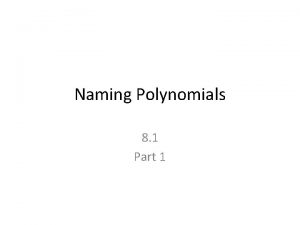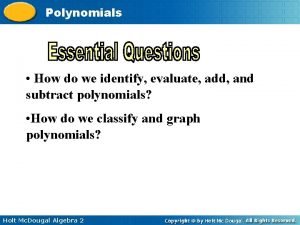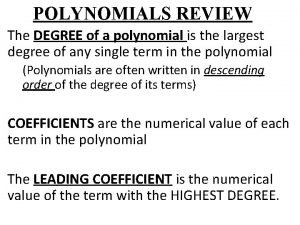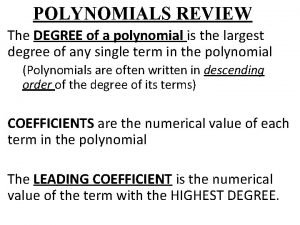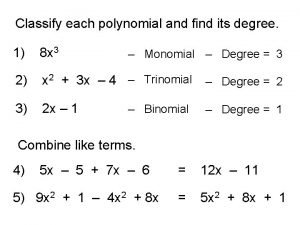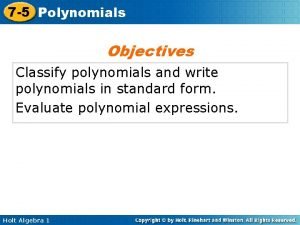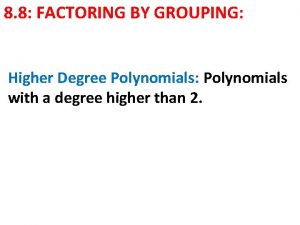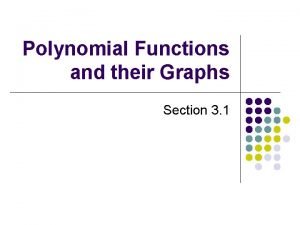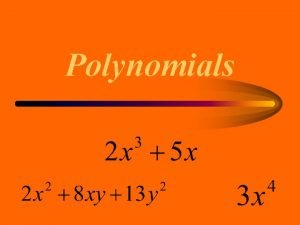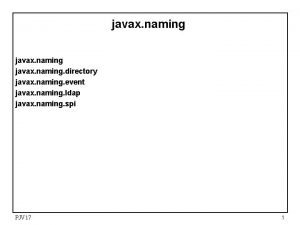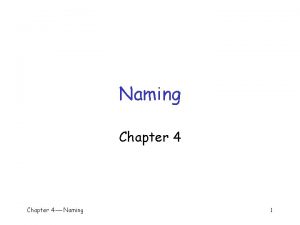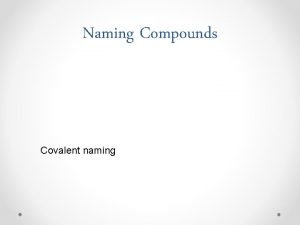Polynomials P 4 Naming Polynomials Terms Degree 1


















- Slides: 18

Polynomials P 4

Naming Polynomials # Terms Degree 1 – Monomial 1 – Linear 2 – Binomial 2 – Quadratic 3 – Trinomial 3 – Cubic 4+ - Polynomial 4 + - 4 th degree, etc. Practice: • If a does not equal 0, the degree of axn is n. • Degree of polynomials is the greatest degree of all its terms • The degree of a nonzero constant is 0. • The constant 0 has no defined degree. 3 x 4 = 4 th degree monomial 5 xy 2= Cubic monomial 3 xy +3 x +4 = Quadratic Trinomial 3 x 4 +5 xy + 6 x + 2= 4 th degree polynomial 3 x 2 +6 x = Quadratic binomial 3 x 3+6 x 2+2 x = Cubic Trinomial

Definition of a Polynomial in x • A polynomial in x is an algebraic expression of the form anxn + an-1 xn-1 + an-2 xn-2 + … + a 1 n + a 0 where an, an-1, an-2, …, a 1 and a 0 are real numbers, an ≠ 0, and n is a non-negative integer. The polynomial is of degree n, an is the leading coefficient, and a 0 is the constant term.

Definition of a Polynomial in x • A polynomial in x is an algebraic expression of the form anxn + an-1 xn-1 + an-2 xn-2 + … + a 1 n + a 0 where an, an-1, an-2, …, a 1 and a 0 are real numbers, an ≠ 0, and n is a non-negative integer. The polynomial is of degree n, an is the leading coefficient, and a 0 is the constant term. Identify the …degree? …leading coefficient? …. and constant term? 3 x 8 + 5 x 4 + 2

Standard Form of a Polynomial Write in order of descending powers of the variable So… 3 x + 5 x 8 - 9 x 3 + 10 should be written 5 x 8 - 9 x 3 +3 x +10

Adding and Subtracting Polynomials (Ex#1) Perform the indicated operations and simplify: (-9 x 3 + 7 x 2 – 5 x + 3) + (13 x 3 + 2 x 2 – 8 x – 6) Solution (-9 x 3 + 7 x 2 – 5 x + 3) + (13 x 3 + 2 x 2 – 8 x – 6) = (-9 x 3 + 13 x 3) + (7 x 2 + 2 x 2) + (-5 x – 8 x) + (3 – 6) = 4 x 3 + 9 x 2 – (-13 x) + (-3) = 4 x 3 + 9 x 2 + 13 x – 3 Group like terms. Combine like terms.

Multiplying Polynomials (Ex #2) The product of two monomials is obtained by using properties of exponents. For example, (-8 x 6)(5 x 3) = -8· 5 x 6+3 = -40 x 9 Multiply coefficients and add exponents. Furthermore, we can use the distributive property to multiply a monomial and a polynomial that is not a monomial. For example, 3 x 4(2 x 3 – 7 x + 3) = 3 x 4 · 2 x 3 – 3 x 4 · 7 x + 3 x 4 · 3 = 6 x 7 – 21 x 5 + 9 x 4. monomial trinomial

Multiplying Polynomials when Neither is a Monomial (Ex #3) • Multiply each term of one polynomial by each term of the other polynomial. Then combine like terms.

Using the FOIL Method to Multiply Binomials last first (ax + b)(cx + d) = ax · cx + ax · d + b · cx + b · d Product of inner outer First terms Outside terms Inside terms Last terms

Ex #3 Multiply: (3 x + 4)(5 x – 3).

Text Example Multiply: (3 x + 4)(5 x – 3). Solution last first F O I L (3 x + 4)(5 x – 3) = 3 x· 5 x + 3 x(-3) + 4(5 x) + 4(-3) = 15 x 2 – 9 x + 20 x – 12 inner = 15 x 2 + 11 x – 12 Combine like terms. outer

The Product of the Sum and Difference of Two Terms (ex #4) DIFFERENCE OF SQUARES • The product of the sum and the difference of the same two terms is the square of the first term minus the square of the second term.

The Square of a Binomial Sum (Ex #5) PERFECT SQUARE TRINOMIAL • The square of a binomial sum is first term squared plus 2 times the product of the terms plus last term squared.

The Square of a Binomial Difference • The square of a binomial difference is first term squared minus 2 times the product of the terms plus last term squared.

Special Products Let A and B represent real numbers, variables, or algebraic expressions. Special Product Example Sum and Difference of Two Terms (A + B)(A – B) = A 2 – B 2 (2 x + 3)(2 x – 3) = (2 x) 2 – 32 = 4 x 2 – 9 Squaring a Binomial (A + B)2 = A 2 + 2 AB + B 2 (A – B)2 = A 2 – 2 AB + B 2 (y + 5) 2 = y 2 + 2·y· 5 + 52 = y 2 + 10 y + 25 (3 x – 4) 2 = (3 x)2 – 2· 3 x· 4 + 42 = 9 x 2 – 24 x + 16 Cubing a Binomial (A + B)3 = A 3 + 3 A 2 B + 3 AB 2 + B 3 (A – B)3 = A 3 – 3 A 2 B – 3 AB 2 + B 3 (x + 4)3 = x 3 + 3·x 2· 4 + 3·x· 42 + 43 = x 3 + 12 x 2 + 48 x + 64 (x – 2)3 = x 3 – 3·x 2· 2 – 3·x· 22 + 23 = x 3 – 6 x 2 – 12 x + 8

Text Example Multiply: a. (x + 4 y)(3 x – 5 y) b. (5 x + 3 y) 2 Solution We will perform the multiplication in part (a) using the FOIL method. We will multiply in part (b) using the formula for the square of a binomial, (A + B) 2. a. (x + 4 y)(3 x – 5 y) Multiply these binomials using the FOIL method. F O I L = (x)(3 x) + (x)(-5 y) + (4 y)(3 x) + (4 y)(-5 y) = 3 x 2 – 5 xy + 12 xy – 20 y 2 = 3 x 2 + 7 xy – 20 y 2 Combine like terms. • (5 x + 3 y) 2 = (5 x) 2 + 2(5 x)(3 y) + (3 y) 2 = 25 x 2 + 30 xy + 9 y 2 (A + B) 2 = A 2 + 2 AB + B 2

Example • Multiply: (3 x + 4)2. Solution: ( 3 x + 4 )2 =(3 x)2 + (2)(3 x) (4) + 42 =9 x 2 + 24 x + 16

Polynomials
 How do you classify a polynomial by degree
How do you classify a polynomial by degree Naming polynomials
Naming polynomials Classifying polynomials by degree
Classifying polynomials by degree Like terms and unlike terms in polynomials
Like terms and unlike terms in polynomials Naming polynomials calculator
Naming polynomials calculator Naming polynomials
Naming polynomials Polynomial written in standard form
Polynomial written in standard form Polynomial review
Polynomial review Naming polynomials calculator
Naming polynomials calculator Classify each polynomial
Classify each polynomial Classify a polynomial
Classify a polynomial Polynomial
Polynomial Combining like terms definition
Combining like terms definition Factoring higher degree polynomials
Factoring higher degree polynomials What is constant polynomial
What is constant polynomial Polynomial vs binomial
Polynomial vs binomial Naming contest rules
Naming contest rules Naming binary ionic compounds
Naming binary ionic compounds Aldehydes and ketones
Aldehydes and ketones

